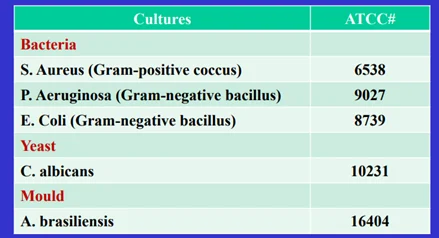Essentials of Preservation
✔ Preservatives (or biocides) are essential additives in the manufacturing of water-based products, because they prevent the undesirable overgrowth of microorganisms (bacteria, fungi, algae)
✔ Preservation – A process by which chemical agents (BIOCIDES) prevent microbial deterioration of materials and thus prolong the intended shelf life of product
✔ Microbial deterioration is the process by which microorganisms break down materials, leading to physical and chemical changes such as discolouration, gas generation, malodour, changes in pH and viscosity, sedimentation, agglomeration, phase separation etc
✔ Water is a fundamental growth factor for most microorganisms
Biocide Prevention
✔ The prevention of microbial contaminations requires the use of biocides and that all manufacturing steps must be closely monitored; encompassing control of process water, raw materials (powders, dispersions or emulsions), plant hygiene, packaging, etc
✔ The predominant biocides currently used for in-can preservation of water-based products include formaldehyde-donors (e.g. Triazines) and Isothiazolinones (e.g. CMIT. MIT, BIT) and synergistic blends
General Requirements for of Biocides
✔ Broad spectrum antimicrobial activity (bacteria, yeasts and moulds)
✔ Temperature and pH stability
✔ Aqueous based solutions or dispersions for ease of handling and incorporation
✔ Compatibility with formulation
✔ Environmentally friendly
✔ Low health hazard e.g. skin irritation and allergic reaction
✔ Meeting Regulatory compliance (EPA, FDA, BPR, BfR, REACH, EU CLP)
✔ Cost effective
Biocides Application
✔ In-can Protection – To prevent spoilage of water-based product during storage and transportation
Desired Characteristics of an Efficient In-can Biocide
- A broad-spectrum antimicrobial efficacy
- Long-term protection as products may be kept in storage for long periods and exposed to wide temperature variations
- While some actives are effective against bacteria and fungi, synergistic and complementary blend of biocides would be a better option
✔ Dry-film Protection – To ensure satisfactory long-term performance of coating on exposure to environmental conditions
Advantages of the Use of Blend of Biocides for Optimised Performance of In-can Preservatives
✔ Reduced dosage
✔ Fast-acting/longer term protection
✔ Broader antimicrobial spectrum
✔ Improved formulation compatibility
✔ Increased cost effectiveness
✔ Minimise health hazards to meet regulatory labelling requirement
✔ Promotion of environmentally friendly end products
Biocide Efficacy: Minimum Inhibitory Concentration (MIC)
✔ The measurement of Minimum Inhibitory Concentration (MIC) is a good way to test biocide efficacy. MIC is the lowest preservative concentration at which growth of a test organism is inhibited (biostatic) under laboratory conditions.
✔ The MIC assay is commonly performed by:
- Agar Dilution
- Broth Dilution
Classification, Labelling and Packaging (CLP) Regulation EC 1272/2008 (UNGHS) and EUH 208 Regulation (2015)
✔ CLP is the European implementation of Globally Harmonised System of Classification and Labelling of Chemicals (GHS)
✔ Labelling with EU H Phrase: EUH 208 Regulation (2015)
- The labelling of chemicals in the European Union and European Economic Area goes further with the additional so–called “EUH sentences”. They are specified in Annex II of Regulation (EC) No 1272/2008 on classification, labelling and packaging of substances and mixtures (“CLP Regulation”), as special rules for labelling and packaging of certain substances and mixture
✔ Isothiazolinones have the potential to produce skin irritation and cause allergic reactions (Skin Sensitisation Category 1), hence the need of cautionary Health Hazard Statement in labelling

Challenge Test – Antimicrobial Effectiveness
✔ A challenge test is a procedure in which a product is challenged by exposure to specified types of bacteria and fungi.
✔ The product is then incubated at a given temperature, samples are taken at specified intervals and the number of microorganisms is determined.
Typical incubation conditions are:
- Bacteria 30-35°C / 18-24 h
- Yeasts 20-25°C / 44-52 h
- Moulds 20-25°C / 6-10 days
✔ Example of Recommended Challenge Microorganisms (USP 35 Chapter 51)

ATCC American Type Culture Collection

